|
|
|
Sort Order |
|
|
|
Items / Page
|
|
|
|
|
|
|
| Srl | Item |
| 1 |
ID:
094414
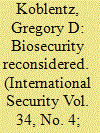

|
|
|
|
|
| Publication |
2010.
|
| Summary/Abstract |
Advances in science and technology, the rise of globalization, the emergence of new diseases, and the changing nature of conflict have increased the risks posed by naturally occurring and man-made biological threats. A growing acceptance of a broader definition of security since the end of the Cold War has facilitated the rise of biosecurity issues on the international security agenda. Developing strategies to counter biological threats is complicated by the lack of agreement on the definition of biosecurity, the diverse range of biological threats, and competing perspectives on the most pressing biological threats. A comprehensive definition of biosecurity that encompasses naturally occurring, accidental, and deliberate disease outbreaks can help to further research, analysis, and policymaking. Operationalizing this broad conception of biosecurity requires a taxonomy of biological threats based on a levels-of-analysis approach that identifies which types of actors are potential sources of biological threats and the groups most at risk from these threats. A biosecurity taxonomy can provide a common framework for the multidisciplinary research and analysis necessary to assess and manage these risks. It also has implications for how to prevent and respond to biological threats, as well as for the future of biosecurity research.
|
|
|
|
|
|
|
|
|
|
|
|
|
|
|
|
| 2 |
ID:
171180
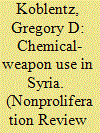

|
|
|
|
|
| Summary/Abstract |
International efforts to hold the government of President Bashar al-Assad accountable for the use of chemical weapons in the Syrian Civil War have entered a new phase. For the first time, the Organisation for the Prohibition of Chemical Weapons (OPCW), the international organization responsible for implementing the 1993 Chemical Weapons Convention, has been empowered to identify the perpetrators of chemical attacks in Syria. The Investigation and Identification Team (IIT), which was formed to conduct the OPCW’s new attribution mission, has announced its intention to investigate and identify the perpetrators of nine chemical attacks in Syria, including the April 7, 2018, attack in Douma. This article reviews recent efforts to attribute chemical attacks in Syria, describes what we know about the nine incidents to be investigated, summarizes what is known about the Syrian government officials, military commanders, and chemical-warfare scientists suspected of being responsible for these attacks, discusses what to expect during the next phase of the attribution process, and offers insights into how the international community can move beyond attribution to accountability. Accountability is necessary to provide justice for victims and to prevent future incidents by demonstrating that perpetrators of chemical attacks will be identified and punished.
|
|
|
|
|
|
|
|
|
|
|
|
|
|
|
|
| 3 |
ID:
171181


|
|
|
|
|
| Summary/Abstract |
Novichok agents are a class of nerve agents developed by the Soviet Union during the Cold War. In light of the use of a Novichok agent in Salisbury in March 2018, two sets of proposals to amend Schedule 1 of the 1993 Chemical Weapons Convention (CWC) have been put forth, one jointly by the United States, Canada, and the Netherlands, and the other by Russia. Both sets of proposals will be discussed and voted upon at the next Conference of States Parties of the Organisation for the Prohibition of Chemical Weapons (OPCW) in November 2019. If either set of proposals is approved, it will be the first time that the list of chemicals subject to verification under the CWC will have been modified. This viewpoint will discuss these proposals, and argue that, if adopted, the joint proposal and the portions of the Russian proposal upon which consensus can be reached would significantly strengthen the CWC by considerably expanding the coverage of its Schedule 1 and bringing Novichok agents firmly within the CWC’s verification system. We also argue that, since the OPCW Technical Secretariat did not deem the fifth group of chemicals proposed by Russia to meet the criteria for inclusion in Schedule 1, Russia should withdraw this part of its proposal from consideration. The proposals have also served an important purpose in clarifying the identity of the chemical agent used in the Salisbury incident, squarely placing it within one of the two families of Novichok agents described by the Russian chemical-weapons scientist and whistleblower Vil Mirzayanov. If either proposal is approved in November, it will be important to conduct a thorough assessment of key precursors for the synthesis of Novichok agents and assess the need to amend CWC schedules and national and multinational export-control lists accordingly.
|
|
|
|
|
|
|
|
|
|
|
|
|
|
|
|
| 4 |
ID:
174236


|
|
|
|
|
| Summary/Abstract |
As part of a nuclear security summit in 2016, fifty world leaders participated in a crisis simulation of a radiological terrorist attack. According to the scenario, the radiological material was stolen from a hospital and sold via the Dark Web to a terrorist group that delivered it using a drone against a civilian target. 1 The scenario, while fictional, was firmly rooted in technological developments that present a new range of challenges to preventing non-state actors from acquiring and using chemical, biological, radiological, and nuclear (CBRN) weapons.
|
|
|
|
|
|
|
|
|
|
|
|
|
|
|
|
| 5 |
ID:
111694
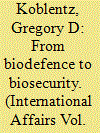

|
|
|
|
|
| Publication |
2012.
|
| Summary/Abstract |
The Seventh Review Conference of the Biological Weapons Convention (BWC), the first international treaty to outlaw an entire class of weapons, was held in Geneva in December 2011. On 7 December, Secretary of State Hillary Clinton became the highest-ranking US government official to address a BWC meeting. Secretary Clinton told the assembled delegation that 'we view the risk of bioweapons attack as both a serious national security challenge and a foreign policy priority'. At the same time, she warned that a large-scale disease outbreak 'could cripple an already fragile global economy'. Secretary Clinton's speech reflected a new understanding that the range of biological threats to international security has expanded from state-sponsored biological warfare programmes to include biological terrorism, dual-use research and naturally occurring infectious diseases such as pandemics. Recognizing these changes, President Barack Obama released a new national strategy for countering biological threats in 2009. This strategy represents a shift in thinking away from the George W. Bush administration's focus on biodefence, which emphasized preparing for and responding to biological weapon attacks, to the concept of biosecurity, which includes measures to prevent, prepare for and respond to naturally occurring and man-made biological threats. The Obama administration's biosecurity strategy seeks to reduce the global risk of naturally occurring and deliberate disease outbreaks through prevention, international cooperation, and maximizing synergies between health and security. The biosecurity strategy is closely aligned with the Obama administration's broader approach to foreign policy, which emphasizes the pragmatic use of smart power, multilateralism and engagement to further the national interest. This article describes the Obama administration's biosecurity strategy; highlights elements of continuity and change from the policies of the Bush administration; discusses how it fits into Obama's broader foreign policy agenda; and analyses critical issues that will have to be addressed in order to implement the strategy successfully.
|
|
|
|
|
|
|
|
|
|
|
|
|
|
|
|
| 6 |
ID:
112279


|
|
|
|
|
| Publication |
Ithaca, Cornell University Press, 2009.
|
| Description |
xiii, 255p.
|
| Standard Number |
9780801477522
|
|
|
|
|
|
|
|
|
|
|
|
Copies: C:1/I:0,R:0,Q:0
Circulation
| Accession# | Call# | Current Location | Status | Policy | Location |
| 056413 | 358.38/KOB 056413 | Main | On Shelf | General | |
|
|
|
|
| 7 |
ID:
107464


|
|
|
|
|
| Publication |
2011.
|
| Summary/Abstract |
The Seventh Review Conference of the Biological Weapons Convention in December 2011 provides an opportunity to modernize the treaty to better address the challenges of the 21st century. The key to this modernization is to redesign the treaty's Confidence-Building Measures (CBMs), the only formal mechanism for increasing transparency and demonstrating compliance with the treaty, to address changes in the global scientific, health, and security environments since the end of the Cold War. The scope of the CBMs should be expanded beyond state-run biological warfare programs to encompass a broader array of threats to global security, such as biological terrorism, laboratory accidents, dual-use research, and disease pandemics. Modernizing the CBM mechanism to take into account these new risks would extend the transparency-enhancing benefits of CBMs to a range of new and important topics, such as biosafety, laboratory biosecurity, and dual-use research oversight; make the CBMs and the treaty itself more relevant to the concerns and priorities of more states; and build on progress made during the recent series of intersessional meetings. To accomplish this, the CBMs need to be revised to shift their focus from hardware, the dual-use capabilities relevant to the treaty, to software, the political and legal institutions that govern the development and use of these capabilities. A more modern CBM mechanism should encourage greater participation in the confidence-building process, improve international cooperation against the full spectrum of biological risks, and promote the goal of universal membership in the treaty.
|
|
|
|
|
|
|
|
|
|
|
|
|
|
|
|
| 8 |
ID:
109782


|
|
|
|
|
| Publication |
2011.
|
| Summary/Abstract |
Since the mid-1990s, academic and policy communities have debated the risk posed by terrorist use of chemical, biological, radiological, or nuclear (CBRN) weapons. Three major schools of thought in the debate have emerged: the optimists, the pessimists, and the pragmatists. Although these three schools of thought draw on the same limited universe of data on CBRN terrorism, they arrive at strikingly different conclusions. Given the highly subjective process of CBRN terrorism risk assessment, this article analyzes the influence of mental shortcuts (called heuristics) and the systemic errors they create (called biases) on the risk assessment process. This article identifies and provides illustrative examples of a range of heuristics and biases that lead to the underestimation of risks, the overestimation of risks and, most importantly, those that degrade the quality of the debate about the level of risk. While these types of biases are commonly seen as affecting the public's perception of risk, such biases can also be found in risk assessments by experts. The article concludes with recommendations for improving the CBRN risk assessment process.
|
|
|
|
|
|
|
|
|
|
|
|
|
|
|
|
| 9 |
ID:
124999
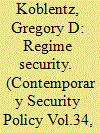

|
|
|
|
|
| Publication |
2013.
|
| Summary/Abstract |
The literature on the proliferation of chemical and biological weapons (CBW) emphasizes the role of external security threats as the primary motive for states to acquire and use these weapons. As recent events in Syria demonstrate, governments lacking political legitimacy may use these weapons to repress domestic challenges to their rule. The concept of regime security provides a theoretical framework for understanding how the threat of military coups, insurgencies, or domestic rivals influences the acquisition and use of CBW by authoritarian regimes. The cases of South Africa and Iraq illustrate how a government's concerns about internal security threats can impact its CBW proliferation decision-making. Omitting regime security as a factor in CBW decision-making may lead to the adoption of inappropriate nonproliferation and deterrent strategies. In light of Syrian President Bashar al-Assad's use of chemical weapons against his own people, developing a deeper understanding of the influence of regime security on the acquisition and use of chemical and biological weapons should be a priority.
|
|
|
|
|
|
|
|
|
|
|
|
|
|
|
|
| 10 |
ID:
157893
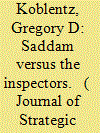

|
|
|
|
|
| Summary/Abstract |
The discovery that Iraq had no weapons of mass destruction (WMD) in 2003 raised the question of why Saddam had prevented UN weapons inspectors from fully accounting for his disarmament. The leading explanation for Saddam’s behavior is that he valued ambiguity as part of a strategy of ‘deterrence by doubt’. This article argues that Iraq’s obstruction of inspectors in the late 1990s was motivated by his desire to shield Iraq’s regime security apparatus from UNSCOM’s intrusive counter-concealment inspections. The failure to understand how strongly Saddam’s concerns about his personal safety drove Iraq’s contentious relationship with UNSCOM set the stage for the invasion of Iraq in 2003.
|
|
|
|
|
|
|
|
|
|
|
|
|
|
|
|
| 11 |
ID:
187492
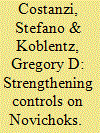

|
|
|
|
|
| Summary/Abstract |
Novichoks, also known as A-series agents, are nerve agents developed in the Soviet Union during the Cold War. Once obscure chemicals, they garnered a great deal of attention after their employment in the attempted assassinations of Sergei and Yulia Skripal in 2018 and of Alexei Navalny in 2020. Novichok agents were not originally featured in the schedules of the Chemical Weapons Convention (CWC), which are intended to support the treaty’s verification regime and declaration requirements. However, following the Skripal incident, the CWC schedules were amended to include Novichok agents. Furthermore, precursors for their synthesis were added to the Australia Group’s (AG) list of chemical-weapons precursors. In this article, we evaluate the recent revisions of the CWC schedules and the AG precursors list, identify the remaining weaknesses of both lists, and make recommendations for further amendments. We recommend strengthening the coverage of the CWC schedules by adding families of Novichok agents with guanidine branches. This is particularly important in light of the Navalny incident, since that incident appears to have involved a guanidine-bearing Novichok agent currently not covered by the CWC schedules. We also propose an approach to the control of Novichok precursors by the CWC and the AG based on families of chemicals rather than individually enumerated chemicals.
|
|
|
|
|
|
|
|
|
|
|
|
|
|
|
|
| 12 |
ID:
096004
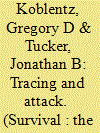

|
|
|
|
|
| Publication |
2010.
|
| Summary/Abstract |
On 18 September 2001, exactly one week after the 11 September terrorist attacks in the United States, five letters containing dry powdered spores of Bacillus anthracis - rugged, seed-like forms of the bacterium that causes anthrax - were mailed to media outlets in Florida and New York City. Three weeks later, two more letters containing a more refined preparation of anthrax spores were sent to US Senators Tom Daschle and Patrick Leahy in Washington DC. The tainted letters contaminated several buildings and caused 22 cases of anthrax (half involving the skin and half the lungs) in five states and the District of Columbia. Five of the people who contracted the inhalational form of anthrax died: two US Postal Service employees in Washington; an employee of American Media, Inc. in Boca Raton, Florida; a 94-year-old woman in Oxford, Connecticut; and a hospital worker in New York City. The anthrax letter attacks also had pervasive ripple effects, forcing thousands of people to take antibiotics as a precaution, disrupting the US Postal Service, temporarily shutting down the US Senate, causing nationwide anxiety about the safety of the mail, and triggering a flood of false alarms and hoaxes involving white powders. All told, the cost of the incident was estimated at $6 billion.
|
|
|
|
|
|
|
|
|
|
|
|
|
|
|
|
| 13 |
ID:
048565


|
|
|
|
|
| Publication |
Washington, Carnegie Endowment for International Peace, 1998.
|
| Description |
viii, 327p.
|
| Standard Number |
0870031139
|
|
|
|
|
|
|
|
|
|
|
|
Copies: C:2/I:0,R:0,Q:0
Circulation
| Accession# | Call# | Current Location | Status | Policy | Location |
| 040298 | 355.825119/JON 040298 | Main | On Shelf | General | |
| 040642 | 355.825119/JON 040642 | Main | On Shelf | General | |
|
|
|
|
| 14 |
ID:
173012


|
|
|
|
|
| Summary/Abstract |
In late June 2018, Charlie Rowley and Dawn Sturgess, residents of Amesbury in the United Kingdom, discovered a discarded perfume bottle. Just 15 minutes after Sturgess sprayed her wrists to test the scent at home, she became ill and, nine days later, became the only fatality from a chemical weapons agent used in the UK. Rowley, exposed to a lesser degree, survived after multiple hospitalizations.
|
|
|
|
|
|
|
|
|
|
|
|
|
|
|
|
| 15 |
ID:
124782


|
|
|
|
|
| Publication |
2013.
|
| Summary/Abstract |
Since the beginning of the twenty-first century, two new threats have received increased attention: biological warfare (BW) and cyber warfare. While it may appear that these two threats have little in common, they share several characteristics that have significant implications for international security. This article examines the two modalities side-by-side to review these common characteristics. In light of these commonalities and due to the extensive experience and rich history of dealing with BW threats, strategies for enhancing cyber security could advance more quickly by drawing meaningful insights from the biological warfare experience, such as the prospect of developing constraining international norms.
|
|
|
|
|
|
|
|
|
|
|
|
|
|
|
|
|
|
|
|
|